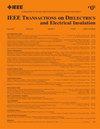Nanocomposite-Based Insulation Systems: A Review of Materials and Techniques for High-Voltage Applications
IF 3.1
3区 工程技术
Q2 ENGINEERING, ELECTRICAL & ELECTRONIC
IEEE Transactions on Dielectrics and Electrical Insulation
Pub Date : 2025-03-30
DOI:10.1109/TDEI.2025.3574950
引用次数: 0
Abstract
Compared to conventional insulation materials, nanocomposite (NC)-based insulation systems represent novel progress in high-voltage (HV) systems, offering superior electrical, thermal, and mechanical properties. This review comprehensively analyzes the materials and fabrication methods used to develop NC insulation systems with a well-defined application, such as energy storage devices, power transmission lines, transformers, and capacitors. Nanoparticles (NPs) such as carbon nanotubes (CNTs), graphene, alumina, and boron nitride (BN) can enhance dielectric breakdown strength, mechanical robustness, and thermal conductivity. NCs offer reduced dielectric loss and adjustable permittivity, making them ideal candidates for energy storage and capacitive applications. However, some challenges remain in the large-scale fabrication of NC insulation systems. Cost considerations, controlling filler-matrix interactions, preventing NP agglomeration, achieving uniform NP dispersion within the polymer matrix, and scaling up production are key issues. Agglomeration, which leads to uneven NP distribution, negatively affects the material’s properties and performance, making it one of the major tasks to solve for improving NC systems. Developing biodegradable and recyclable NCs and exploring new nanomaterials are the future perspectives of hybrid insulation systems. This progress could result in more sustainable, multifunctional insulation materials and efficient systems for next-generation HV applications. This review outlines both the current state and prospects of NC insulation systems in power systems.纳米复合材料基绝缘系统:高压应用材料和技术综述
与传统的绝缘材料相比,基于纳米复合材料(NC)的绝缘系统代表了高压(HV)系统的新进展,具有优越的电气、热学和机械性能。本文全面分析了用于开发具有明确应用的数控绝缘系统的材料和制造方法,例如储能设备,输电线路,变压器和电容器。纳米颗粒(NPs),如碳纳米管(CNTs)、石墨烯、氧化铝和氮化硼(BN)可以提高介质击穿强度、机械稳健性和导热性。nc提供了更低的介电损耗和可调的介电常数,使其成为能量存储和电容应用的理想候选者。然而,在数控绝缘系统的大规模制造中仍然存在一些挑战。成本考虑、控制填料-基质相互作用、防止NP团聚、实现NP在聚合物基质内均匀分散以及扩大生产规模是关键问题。团聚会导致NP分布不均匀,对材料的性能产生负面影响,是数控系统改进需要解决的主要问题之一。开发可生物降解和可循环利用的纳米材料和探索新型纳米材料是混合绝缘系统的未来发展方向。这一进展可能会为下一代高压应用带来更可持续、多功能的绝缘材料和高效的系统。本文综述了电力系统中数控绝缘系统的现状和发展前景。
本文章由计算机程序翻译,如有差异,请以英文原文为准。
求助全文
约1分钟内获得全文
求助全文
来源期刊
CiteScore
6.00
自引率
22.60%
发文量
309
审稿时长
5.2 months
期刊介绍:
Topics that are concerned with dielectric phenomena and measurements, with development and characterization of gaseous, vacuum, liquid and solid electrical insulating materials and systems; and with utilization of these materials in circuits and systems under condition of use.

 求助内容:
求助内容: 应助结果提醒方式:
应助结果提醒方式:


